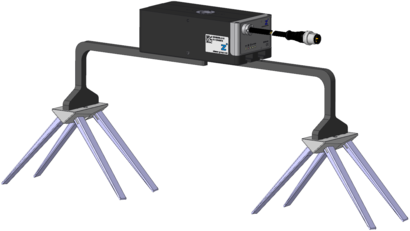EU Research Project SOFTMANBOT - Project Update Zimmer Group
EU Research Project SOFTMANBOT - Project Update Zimmer Group
In the past 12 months, the research project SOFTMANBOT has brought many developments to the Zimmer Group despite the difficult conditions caused by the Corona Pandemic. So even before the lockdown, visits could be made to the project partners JUEMA (Alicante, Spain), PLASTINHER URBAN S.L (Elche, Spain) and DECATHLON (Tirana, Albania). Only the visit to MICHELIN (Clermont-Ferrand) is still pending. In addition to personal exchanges, the on-site meetings were important in order to better understand the use cases.
This included an analysis of the work to be carried out and a transfer of these tasks into capability descriptions, so-called skills, which for example the future handling system should fulfil. In addition, the sensor information required to detect the component state were identified. This step was particularly important because the developments are to be tested and proven later on the basis of these use cases.
Since many research topics in SOFTMANBOT deal with the manipulation of flexible components and this is investigated with different simulation models, virtual description models of the end-effectors (e.g. grippers) are created in parallel. These digital twins are used to simulate the working steps of the robot system in advance.
In the following we want to describe our development work on two of the four use cases in more detail.
Use case at JUEMA (Juema is a company with more than 30 years of experience in the production of high quality dolls)
In a first step, the different doll parts have to be pulled out of the mould. Until now this has been done by a worker with simple pliers. For this step, the Zimmer Group is planning to develop a pneumatic gripper with integrated (electrically controlled) valves, which can be pre-positioned and can readjust the grip force if necessary. It is particularly important to the engineers that the necessary sensitivity is achieved so that the workpieces are not damaged. By generating a vacuum, the part can be detached from the mould wall more easily. When assembling the doll, intelligent robot programming in combination with the necessary sensor technology is a key element. The Zimmer Group is going to develop a tactile working, electric long-stroke gripper for this task, which will allow the widest possible range of applications to be covered. For the manipulation of the parts, it is necessary to precisely detect both the contact positions and the contact force.
Use case at Decathlon (Decathlon in Albania produces, among other things, cycling shorts)
For Decathlon two separate systems must work together, since the padding (turquoise) of the cycling shorts must be placed individually (on a curved negative form) and held in position during sewing. Here a needle gripper can be used, which is mounted on a bendable carrier (yellow). To be able to drape the fabric wrinkle-free, a system must be developed that can stretch. For initial small preliminary investigations and to better demonstrate our handling approach, the Zimmer Group has already engineered and manufactured some initial prototype parts. These will be tested very soon. The idea of the Zimmer Group specialists is to use gripper fingers that spread out when pressed down so that the fabric will be stretched. The gripper used here has a large stroke and is used for pre-positioning.
In the upcoming project year, first prototypes of these technologies will be tested by the project partners. For this purpose, the manufacturing facilities were reproduced in a simplified form. In addition to the functional tests, these mock-up's can also be used to test the interfaces of all involved systems.

